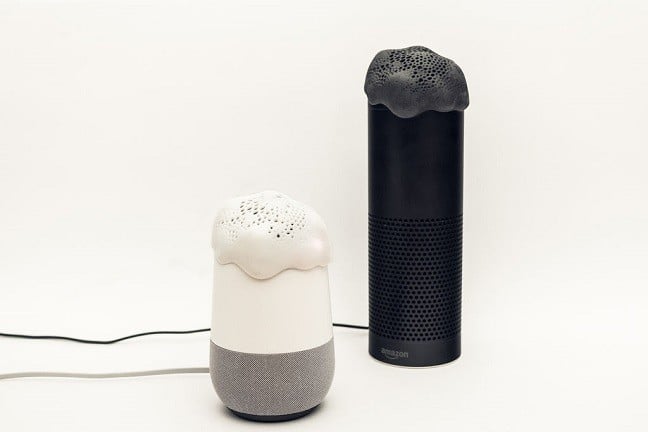You got a smart speaker but you’re worried about privacy. First off, why’d you buy one? Secondly, check out Project Alias

Project Alias is a homebrew gizmo that aims to deafen Alexa and Google Home until a user is good and ready for the creepy little cylinders to pay attention.
By following an Instructable from Amsterdam-based Bjørn Karmann and Tore Knudsen, those confident with a soldering iron can build their own kit using a Raspberry Pi A+ and some inexpensive bits and pieces.
If you have access to a 3D printer you can also add the cover, which looks like someone has been a bit poorly on top of your home automation assistant, or held it over a fire.
The Register spoke to one of its creators, Knudsen, who explained how it works. Speakers are placed over the mic array of the smart speaker and connected to the Raspberry Pi. The Pi then plays a mix of human speech and noises at a volume too low for us to hear, but loud enough to keep the likes of Alexa deafened.
The Pi has ears of its own in the form of a couple of microphones on an inexpensive daughterboard, and is trained by the user via a simple smartphone app to accept whatever activation phrase is needed. When the Pi “hears” the user’s preferred phrase, it triggers Alexa or Google Home itself and then allows the user’s instructions to make it to the spy cylinder’s ears.
The thing is wrapped up in a 3D-printed shell that resembles something that might attach itself to Spock in one of the older and more prosthetically creative episodes of Star Trek.
There is unbound potential for nerdery in that two-second wake-up phrase.
Though the Pi still requires power (necessitating a potentially messy extra cable), it does not need to be connected to the internet in order for the giant snot globule to do its thing.
Alas, you cannot actually buy one of these things (not yet, anyway).
Knudsen told us: “We have from the start decided that it should be open source and a project for the people, and not a consumer product in that sense.” He also warned that the project, which he and Karmann had put together between June and December 2018 “is still a proof of concept and might not work ‘out of the box’.”
While the small team behind the project has been training the thing themselves, Knudsen admitted that “it requires much more data to make a system work in any home with any voice”, adding: “Right now you need to train it from scratch, which is just a temporary solution.”
Much of the fun can also be found on GitHub, where the team hopes “that the open source community will help project Alias to become better”. Judging by the comments thus far, training the thing is indeed proving a challenge, but, as Knudsen observed, it is early days.
Your correspondant had a crack at making one and it went about as well as you would expect, although I am going to blame my abject failure on using the wrong mic board rather than my terrible, terrible soldering skills.
For those blessed with a compatible 3D printer and the ability to wield a soldering iron without making a dreadful hash of things, the Project Alias parasite is, we are assured, a neat project that handily blocks some of the eavesdropping tendencies that worry some smart speaker owners.
As for why the project is required, Knudsen said: “We are bringing so many digital products into our homes and while doing that we are relying on the companies to not misuse this.
“With project Alias we want to show and stress how the control and agency should be distributed more towards the user than the company/product.”
Alternatively, you could simply not put the creepy things in your home and point your phone at a good old-fashioned Bluetooth speaker to make music play, which is what many smart speakers seem to end up doing these days. ®
READ MORE HERE

